32 14 16 3 13 32 | 0 16 3 13 MIN 0 Date 9 January 1977 | |
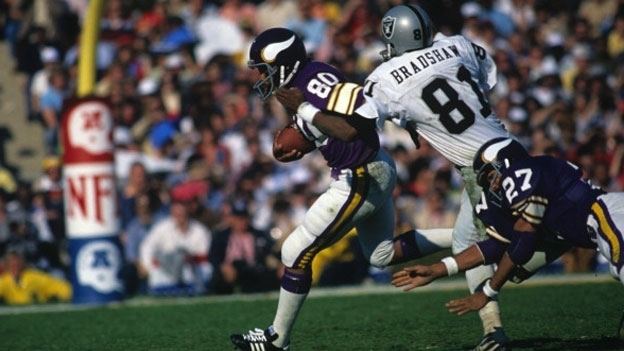 | ||
Similar Super Bowl XV, Super Bowl XII, Super Bowl IX, Super Bowl VIII, Super Bowl XVIII | ||
Super bowl xi raiders vs vikings nfl full game
Super Bowl XI was an American football game between the American Football Conference (AFC) champion Oakland Raiders and the National Football Conference (NFC) champion Minnesota Vikings to decide the National Football League (NFL) champion for the 1976 season. The Raiders defeated the Vikings by the score of 32–14 to win their first Super Bowl. The game was played on January 9, 1977, at the Rose Bowl in Pasadena, California. This is, and remains, the earliest scheduled Super Bowl during the calendar year.
Contents
- Super bowl xi raiders vs vikings nfl full game
- Super bowl xi oakland 32 minnesota 14
- Background
- Oakland Raiders
- Minnesota Vikings
- Playoffs
- Television and entertainment
- Pregame festivities
- Halftime show
- Game summary
- Final statistics
- Individual leaders
- Records Set
- Starting lineups
- Officials
- References
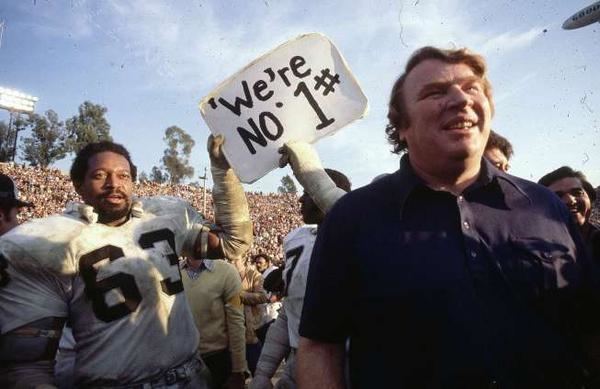
This was the Raiders' second Super Bowl appearance after losing Super Bowl II. They posted a 13–1 regular season record before defeating the New England Patriots and the Pittsburgh Steelers in the playoffs. The Vikings were making their fourth Super Bowl appearance after posting an 11–2–1 regular season record and playoff victories over the Washington Redskins and the Los Angeles Rams. The Vikings became the first team to appear in four Super Bowls, a record they held until the Dallas Cowboys advanced to a Super Bowl for the fifth time in Super Bowl XIII. They had yet to win in their previous three attempts, losing Super Bowl IV to the Kansas City Chiefs in the final Super Bowl before the AFL–NFL merger and following that up with losses in Super Bowls VIII and IX.
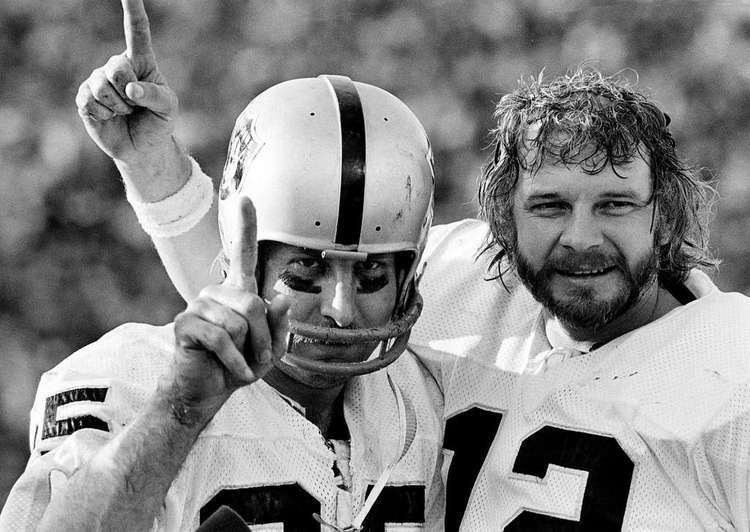
Oakland gained a Super Bowl record 429 yards, including a Super Bowl record 288 yards in the first half, en route to winning Super Bowl XI. After a scoreless first quarter, Oakland scored on three consecutive possessions to take a 16–0 lead at halftime. The Raiders also had two fourth quarter interceptions, including cornerback Willie Brown's 75-yard return for a touchdown. Oakland wide receiver Fred Biletnikoff, who had 4 catches for 79 yards that set up three Raider touchdowns, was named the game's Most Valuable Player (MVP). Among the wide receivers who have won the Super Bowl MVP, Biletnikoff is the only one to not have gained 100 yards in his performance. Ken Stabler of the Raiders became the first left-handed quarterback to win the Super Bowl. He would be joined 18 years later by San Francisco quarterback Steve Young, who led the 49ers to victory against the San Diego Chargers in Super Bowl XXIX.

Super bowl xi oakland 32 minnesota 14
Background
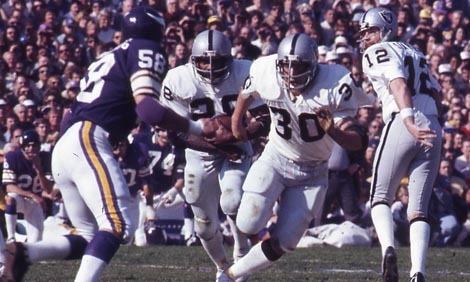
The NFL awarded Super Bowl XI to Pasadena, California on March 19, 1975 at the owners' meetings held in Honolulu. [1]
Oakland Raiders
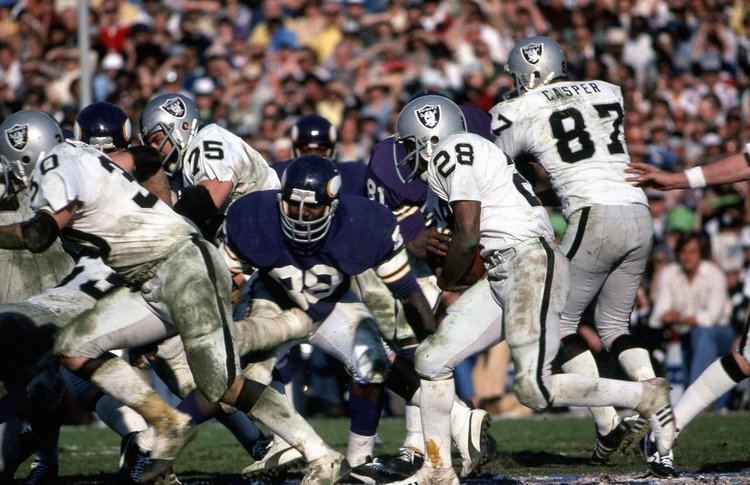
This game marked the second Super Bowl appearance for the Oakland Raiders, who lost Super Bowl II. Two years after their Super Bowl loss, the Raiders hired John Madden as their head coach. Under Madden, the Raiders had posted in his 8 seasons an 83–22–7 record (counting ties, this was a .772 winning percentage, second for any NFL team behind only the Vikings' .781). But Super Bowl XI was the first time Madden led his team to a league championship game. They had been eliminated in all 6 of their previous playoff appearances, including 5 losses in the AFC Championship Game.
The Raiders offense was led by quarterback Ken Stabler, who finished as the top rated passer in the AFC, passing for 2,737 yards and 27 touchdowns. His 66.7 completion percentage (194 completions out of 291 attempts) was the second highest in the league. Stabler's main passing weapon was wide receiver Cliff Branch, who caught 46 passes for 1,111 yards (24.2 yards per catch average) and 12 touchdowns. Fred Biletnikoff was also a reliable deep threat, with 43 receptions for 551 yards and 7 touchdowns. And tight end Dave Casper recorded 53 receptions for 691 yards and 10 touchdowns.
In addition to their great passing attack the Raiders also had a powerful running game, led by fullback Mark van Eeghen (1,012 rushing yards, 17 receptions) and halfback Clarence Davis (516 rushing yards, 27 receptions). Another reason for the Raiders' success on offense was their offensive line, led by left tackle Art Shell and left guard Gene Upshaw, as well as perennial All-Pro center Dave Dalby.
Injuries early in the season forced the Raiders to switch from a 4–3 to a 3–4 defense. The switch benefited the team, as they won their last 10 games and finished the regular season with the best record in the league, 13–1. The Raiders' defense was anchored by great linebackers, such as Phil Villapiano and Ted Hendricks, while defensive end Otis Sistrunk anchored the defensive line. Their defensive secondary was extremely hard-hitting and talented, led by safeties Jack Tatum and George Atkinson, and cornerbacks Skip Thomas and Willie Brown.
Brown, Upshaw, Biletnikoff and running back Pete Banaszak were the only holdovers from the Oakland team that was defeated nine years earlier in Super Bowl II.
Many accused the Raiders defense of being overly aggressive, especially Atkinson, who inflicted a severe concussion on Pittsburgh Steelers wide receiver Lynn Swann in the previous season's AFC Championship Game. Atkinson added to that reputation as the Raiders advanced through the playoffs to Super Bowl XI. In the Raiders' 24–21 playoff win over the New England Patriots, Atkinson broke the nose of Patriots tight end Russ Francis. Then Atkinson inflicted another concussion to Swann in the Raiders' 1976 season opener. In reaction, Pittsburgh head coach Chuck Noll complained of a "criminal element" in Atkinson's play. Atkinson himself denied deliberately trying to injure anyone and pointed out that at 6'0" and 185 pounds, he was one of the smallest players on the field. The Raiders and their fans were often known to counter these accusations against Atkinson and Jack Tatum by pointing out the physical way that Pittsburgh cornerback Mel Blount covered Oakland's speedy split end Cliff Branch.
An interesting fact about the team was that two players (whose names were not revealed) bought marijuana from Red Hot Chili Peppers' singer Anthony Kiedis' father, Blackie Dammett, and smoked it before the game, and played the game under the effects of the drug. This was revealed on Kiedis's biography from 2004, Scar Tissue.
Minnesota Vikings
The Vikings, coached by Bud Grant, won the NFC Central for the eighth time in the last nine seasons with an 11–2–1 record, and advanced to their fourth Super Bowl in eight years. They were the only team who had lost three Super Bowls (they had previously lost Super Bowls IV, VIII and IX), and did not want to be the first one to lose four. They were the first team to appear in a fourth Super Bowl.
Once again, the Vikings had a powerful offense led by 37-year-old quarterback Fran Tarkenton and running back Chuck Foreman. Playing in his 16th NFL season, Tarkenton was already the league's all-time leader in pass completions (3,186), passing yards (41,802), and touchdown passes (308). He had another fine season in 1976, completing 61.9 percent of his passes for 2,961 yards, 17 touchdowns, and only 8 interceptions. Foreman had the best season of his career, rushing for 1,155 yards and 13 touchdowns, while also catching 55 passes for 567 yards and another touchdown. Fullback Brent McClanahan also contributed 634 combined rushing and receiving yards. The Vikings also added two new weapons to their offense: veteran wide receiver Ahmad Rashad and rookie wide receiver Sammy White combined for 104 receptions, 1,577 receiving yards, and 13 touchdowns. And once again, tackle Ron Yary anchored the offensive line.
The Vikings' "Purple People Eaters" defense, anchored by Carl Eller, Jim Marshall, and Alan Page, were also dominating teams again. During this regular season, they led the NFC in fewest points allowed (176). Also, defensive back Nate Wright led the team with 7 interceptions for 47 yards, while safety Paul Krause had 2 interceptions for 21 yards.
Tarkenton became the second quarterback to start three Super Bowls, following his Super Bowl VIII counterpart Bob Griese.
Playoffs
The Vikings went on to dominate the Washington Redskins, 35–20, and defeat the Los Angeles Rams, 24–13, in the playoffs. Ten of the Vikings' points in the NFC Championship Game came from blocked kicks.
The Raiders overcame an 11-point fourth-quarter deficit to defeat the New England Patriots, 24–21, with the aid of a penalty call against the Patriots. New England's Ray Hamilton was tagged for roughing the passer in the fourth quarter, turning an incomplete pass on 3rd and 18 into a first down, and the Raiders went on to score on Stabler's 1-yard touchdown run with 14 seconds left in the contest.
Oakland then faced in the AFC championship game the Pittsburgh Steelers, a team that had won the two previous Super Bowls and defeated the Raiders in the playoffs in three out of the last four seasons. However, coming into this game without injured starting running backs Franco Harris and Rocky Bleier, the Steelers were soundly thrashed this time around, losing to Oakland, 24–7.
This was the first Super Bowl game to match both conferences' No. 1 seeds, and was the last Super Bowl (and first one held in the Rose Bowl) to finish under daylight and where both teams' placekickers (Minnesota's Fred Cox and Oakland's Errol Mann) used the straight-on style. Scheduled on the 9th day of January, the game marks the earliest Super Bowl played during the calendar year. The regular season started one week earlier than usual in order to avoid having playoff games on Christmas Day, which fell on a Saturday in 1976. By moving the season up, the divisional playoffs were held December 18–19, and the conference championship games Sunday, December 26.
Television and entertainment
The game was televised in the United States by NBC with play-by-play announcer Curt Gowdy and color commentator Don Meredith. This was Meredith's last broadcast with NBC, as he returned to ABC to rejoin the Monday Night Football crew for the 1977 season, where he had been a commentator from 1970–73. Bryant Gumbel and Lee Leonard with analyst John Brodie anchored NBC's pregame, halftime and postgame coverage.
Pregame festivities
The pregame festivities featured the Los Angeles Unified School District (LAUSD) All-City Band and frisbee dog Ashley Whippet. Later, singer Vikki Carr sang "America the Beautiful". There was no national anthem played before coin toss. This was the first time that "America the Beautiful" was played at a Super Bowl.
Halftime show
The halftime show was produced by Disney and was based on It's a Small World, an attraction at Disneyland and the Magic Kingdom. The show featured the cast members of The New Mickey Mouse Club. It was the first Super Bowl halftime show to include crowd participation as people in the stadium waved colored placards on cue. The LAUSD All-City Band also played during the show.
Game summary
The Raiders took the opening kickoff and advanced all the way to the Vikings' 12-yard line, but came up empty after kicker Errol Mann hit the left upright on his 29-yard field goal attempt. Later in the quarter, after the teams exchanged punts, the Vikings had a great opportunity to score, when linebacker Fred McNeill blocked a punt from Ray Guy and recovered the ball on the Raiders' 3-yard line. The Vikings' special teams unit was known for blocking kicks, but this was the first time it had happened to Guy. (He would have only three of his punts blocked in his 14-year NFL Hall of Fame career.) However, two plays later, Minnesota running back Brent McClanahan fumbled the ball while being tackled by Raiders linebacker Phil Villapiano, and linebacker Willie Hall recovered the ball for Oakland. The Raiders then marched 90 yards to the Vikings' 7-yard line, with a 35-yard run by Clarence Davis around left end from the Oakland 6-yard line breaking through Minnesota's front. On the drive's sixth play, quarterback Ken Stabler completed a 25-yard pass to tight end Dave Casper, with Casper breaking through what Stabler called "10 tackles." Oakland, however, had to settle for a 24-yard field goal from Mann, giving them a 3–0 lead 48 seconds into the second quarter.
After forcing Minnesota to punt following a three-and-out, Oakland did even better the next time it got the ball. Stabler completed a 19-yard pass to Casper to reach the Vikings' 26. Running back Carl Garrett carried on three consecutive plays and gained 20 yards, then Stabler hit receiver Fred Biletnikoff along the right sideline for five yards to the 1-yard line. The 64-yard drive in 10 plays then concluded on a 1-yard touchdown pass from Stabler to Casper, increasing the Raiders' lead to 10–0. On the Vikings' next possession, running back Chuck Foreman gained seven yards on first down and six yards on second down, but a holding penalty on Ron Yary made it second-down-and-13. Quarterback Fran Tarkenton threw an incomplete pass to rookie receiver Sammy White, then a long pass to Ahmad Rashad was broken up by defensive back Willie Brown, resulting in another three-and-out. Oakland got the ball back in excellent field position, after returner Neal Colzie returned Minnesota's punt 25 yards to the Vikings' 35-yard line. After three running plays, Stabler completed a 17-yard pass to Biletnikoff at the 1-yard line, and running back Pete Banaszak scored a touchdown on the next play, increasing Oakland's lead to 16–0 with 3:33 left in the second quarter, after Mann missed the extra point attempt. To this point, Minnesota had picked up only one first down. They would add one more on a meaningless 26-yard completion from Tarkenton to Foreman on the last play of the half, which ended up being their longest gain of the entire game. The score at halftime marked the fourth time in as many Super Bowl games that the Vikings failed to score in the first half.
The second half began with three consecutive punts, but then Colzie returned the Vikings' second punt of the quarter 12 yards to the Oakland 46-yard line. From there, the Raiders advanced to the Minnesota 23-yard line, aided by an 18-yard run by Davis and a 10-yard reception by wide receiver Cliff Branch, to set up Mann's 40-yard field goal to increase their lead to 19–0.
Tarkenton then threw 3 consecutive incomplete passes on their ensuing drive, forcing the Vikings to punt again. However, Oakland linebacker Ted Hendricks was penalized for running into the punter on the play, giving Minnesota a first down. Taking advantage of their second chance, the Vikings ended up with a 12-play, 68-yard drive as Tarkenton completed passes to Stu Voigt, Ahmad Rashad and Chuck Foreman for gains of 15, 21, and 10 yards. On the last play, Tarkenton threw an 8-yard touchdown pass to Sammy White, making the score 19-7.
The Raiders were forced to punt on their next drive, after they were unable to recover from Alan Page's 11-yard sack on first down. Then aided by Tarkenton's completions to White for gains of 14 and 18 yards, respectively, the Vikings advanced to the Oakland 37-yard line. But on third down and 3, Hall intercepted a pass from Tarkenton and returned it 16 yards to the 46-yard line. Three plays later, Biletnikoff's 48-yard reception moved the ball to the Vikings' 2-yard line, setting up Banaszak's second rushing touchdown to increase Oakland's lead to 26–7. All three Raiders offensive touchdowns had been preceded on the previous play by key Biletnikoff receptions.
White returned the ensuing kickoff 19 yards to the Minnesota 32-yard line, and four plays later, Tarkenton completed a 25-yard pass to receiver Rashad to reach the Oakland 28-yard line. But on the next play, defensive back Willie Brown intercepted a pass intended for White and returned it 75 yards for a touchdown. Although Mann missed the extra point attempt, the Raiders put the game out of reach, 32–7.
After both teams turned the ball over on downs, Minnesota drove 86 yards in 9 plays to score on a 14-yard touchdown pass from backup quarterback Bob Lee to Voigt. The touchdown cut Minnesota's deficit to 32–14, but by then there was only 25 seconds remaining in the game.
Stabler finished the game with 12 out of 19 pass completions for 180 yards and 1 touchdown. Davis, who was the top rusher in the game, gained 137 yards on just 16 rushing attempts, an average of 8.5 yards per carry. Of Davis' 16 carries, 11 were runs to the left side, which is where the blocking of guard Gene Upshaw, tackle Art Shell and Casper dominated defensive end Jim Marshall and linebacker Wally Hilgenberg. Marshall made no tackles in the game and Hilgenberg made only two. Casper finished the game with 4 receptions for 70 yards and 1 touchdown. Colzie returned 4 punts for a Super Bowl record 43 yards. Foreman had a solid performance for Minnesota, contributing 44 rushing yards and 62 receiving yards. Tarkenton completed 17 out of 35 pass attempts for 205 yards, 1 touchdown, and 2 interceptions. White recorded 163 total yards, catching 5 passes for 77 yards and 1 touchdown, rushing once for 7 yards, and returning 4 kickoffs for 79 yards. The Raiders won their first Super Bowl and according to Brown, winning Super Bowl XI "made up for the other Raiders who came before and didn’t have a chance to participate on a winning Super Bowl team. This victory meant not only a lot to me, it meant a lot to the entire Raider organization." The win was particularly satisfying for Brown, who scored a Super Bowl touchdown and earned his first championship ring after 14 years of professional football.
The Vikings finished with a dismal 0-4 Super Bowl record under Bud Grant, even though in the same 8-year span their regular season record was 87-24-1 (more wins than any other NFL team in that span). Grant coached Minnesota eight more seasons, but never managed to guide the team back to a Super Bowl. The team never led in any of the games, so onlookers never saw what the Vikings might do with a lead in any Super Bowl game. Minnesota also never scored any points in the first half. Turnovers robbed the club from a score on three occasions; two of the opportunities were to take a lead (one in this game). The Vikings committed a total of 15 turnovers and forced only three. In their four Super Bowl appearances they averaged only 56.75 yards rushing (a total of 227 yards on 90 carries for just 2.52 yards per carry), while the "Purple People Eaters" yielded a huge 215.5 yards average. After Kansas City rushed 42 times in Super Bowl IV, Oakland became the third consecutive opponent to rush more than 50 times against the Vikings. Minnesota also had just a 49.3 team passer rating to opponents' 105.2. Tarkenton in three appearances completed 46 of 89 passes just for 489 yards, one touchdown, six interceptions and a 43.7 rating. Opponents completed 68.4 percent of their passes. Previously against the Vikings, Kansas City's Len Dawson completed 12 of 17 pass attempts for 142 yards, 1 touchdown and 1 interception for a 90.8 rating in Super Bowl IV; Miami's Bob Griese completed 6 of 7 for 73 yards and a 110.1 rating in Super Bowl VIII; and Pittsburgh's Terry Bradshaw completed 9 of 14 for 96 yards and a touchdown for a 108.0 rating in Super Bowl IX. In this game Stabler completed 12 of 19 for 180 yards and a touchdown, and had a 111.7 passer rating. The Purple People Eaters were dominated in their final Super Bowl appearance as Oakland set Super Bowl records of 266 yards rushing and 429 yards total offense. Slate writer Justin Peters, after viewing every Super Bowl over a two-month period before Super Bowl 50, considered Minnesota the worst franchise in Super Bowl history. He remarked that "the Vikings in the 1970s really pissed me off... Minnesota went to the Super Bowl four separate times from 1970 to 1977 and didn’t score a single first-half point in any of those games. The Vikings had a really, really good defense, and their offense just kept on letting the defense down, game after game after game."
NFL Media analyst Elliot Harrison published an article for the league's website, which ranks all the Super Bowls, with analysis by former Dallas personnel man Gil Brandt. The four games that the Vikings played in are among the seven lowest ranked, along with Super Bowls XXIV, XLVIII and XXIX. That means that the Vikings' four appearances were judged to be the four worst Super Bowls of the first 23 played, as well as the four worst of the first 11, when Minnesota made its last appearance.
Final statistics
Sources: NFL.com Super Bowl XI, Super Bowl XI Play Finder Oak, Super Bowl XI Play Finder Min
Individual leaders
1Completions/attempts 2Carries 3Long gain 4Receptions 5Times targeted
Records Set
The following records were set in Super Bowl XI, according to the official NFL.com boxscore and the ProFootball reference.com game summary.
Some records have to meet NFL minimum number of attempts to be recognized. The minimums are shown (in parenthesis).
Starting lineups
Source:Hall of Fame‡
Officials
Note: A seven-official system was not used until 1978
